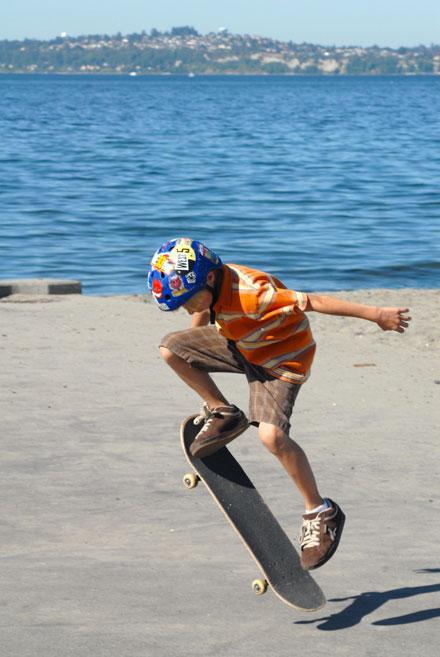Despite objectors, skateboard park idea grows
SKATEBOARDERS DESIRES. "It would be awesome if my friends and I could walk down here every day," said Max Sadow, 10, of a possible skateboard park in the Alki neighborhood. His father notes they have to go to Burien or Renton for skateboarding now. Photo by Steve Shay.
Mon, 09/03/2007
For one skateboarding advocate here, creating a system of skate parks in West Seattle isn't just about building places to do aerials and flip tricks.
So far it's just a blueprint with no funding, but the citywide skate park plan is gaining momentum in West Seattle, fueled by passionate skaters like West Seattle resident Matt Johnston.
Johnston, who served on the skate park advisory task force that helped develop the plan last year with Seattle Parks and Recreation, is also determined to change some minds along the way. At 36, he remembers what it's like to be thought of as a delinquent simply for the kind of sport he enjoys.
"What we want to do in West Seattle is make sure skate parks are successful for everyone in the community and not just the skateboarders, because a successful skate park requires community support," said Johnston. "The last thing we want to do is be skateboarding in a community who hates us or who doesn't want us there."
He brought up a community meeting held this past March to discuss the design of the future Myrtle Street park at the site of Myrtle Reservoir on 35th Avenue Southwest. The location was recommended for a skate facility in the citywide plan but so far the community has been largely opposed to the idea.
Some at the meeting said a skate park would attract "derelict teenagers" and be noisy. Johnston is concerned common fears like these associated with the sport will isolate West Seattle's skate parks and its estimated 4,000 skateboarders.
Built in the right location, with an appropriate design and a welcoming community, skate parks can actually serve as a vibrant part of a neighborhood and discourage bad behavior. But anything pushed to the fringes, whether it's a skate facility or a basketball court, can invite unsavory activities, he said.
"(Skate parks) actually deter bad activities because it programs the space and puts people there," Johnston said. "You have to build it for some people to see how great it can be. This is something positive for the kids."
Some have the idea that skate parks are noisy and messy, but a properly constructed facility only generates about as much sound as an arterial street. And where there is great community support, skateboarders that use the park tend to pick up litter and maintain the park more so than other visitors, Johnston said.
Skatesdots, smaller elements up to 1,500 square feet, and larger skatespots are recommended for the Delridge and Hiawatha playfields, Roxhill Park, Alki Beach and possibly the new Myrtle park. New district skate parks could be located at the High Point and Genesee playfields.
All new facilities would be subject to community input regarding size, location or whether to build one at all.
Johnston and other volunteers with the West Seattle Skatepark Action Group are working on gaining an arsenal of support and have collected more than a thousand signatures. They have developed design mockups for some sites with the help of Grindline, a skateboard design/build contractor headquartered in West Seattle.
Grindline has built parks all over the world, including the one in Ballard, the only skate park currently maintained by the city.
"No one in the city is getting this far ahead of the game," Johnston said. "West Seattle is really unique in that way."
Terry Holme, a member of the board of parks commission, said community support is paramount to the success of the citywide plan.
"This drives just about any of these types of programs, whether it be a ballpark or an off leash dog area," he said. "It really takes a grass roots effort to make these things happen."
When Seattle's Pro Parks Levy sunsets next year, the parks department's budget for new development will be "severely limited," said Joelle Ligon, a parks department spokesperson. The department will go back to its regular capital improvement budget, which is mostly focused on major maintenance to parks.
Johnston said he plans to ask the community for donations and will apply for city matching fund grants, but Holme stressed it will ultimately take political initiative and possibly a bond or levy to fully fund the projects.
"It takes real money to do these things so community fundraising is usually to augment larger capital sources," he said.
Johnston said he wants to show the Seattle City Council and the community that West Seattle will have a system of parks that compliment each other and reflect the local community. Parks could include skateable art developed by local artists, he said.
The group is also planning for potential road bumps. In areas where some opposition is expected, Johnston has come up with what he thinks are "forward thinking, creative (design) solutions."
A facility at Alki, for instance, could be a series of smaller skate features spaced out along a path, with each element large enough for just a few users at a time. It could help ease fears that it would attract large groups at an already busy park.
"People need their sanity and need to feel comfortable in their community, but kids really need something to do," Johnston said. "It's all about location and integration of the skate features."
Rebekah Schilperoort may be reached at 783.1244 or rebekahs@robinsonnews.com
Vote in our online poll about skateparks here


